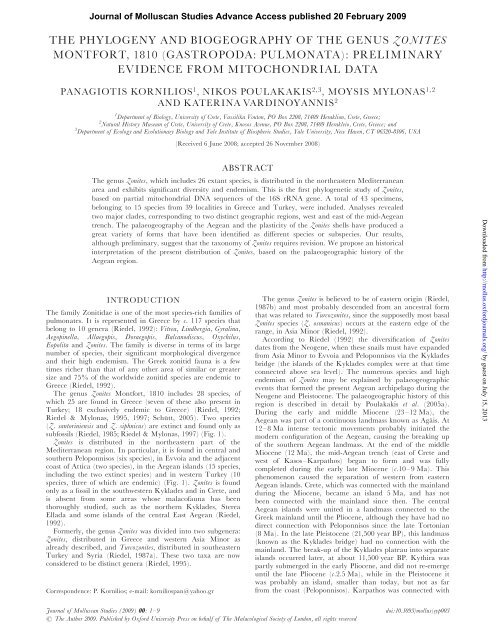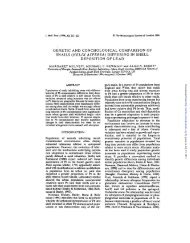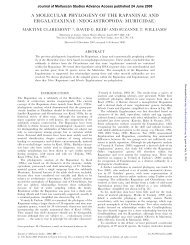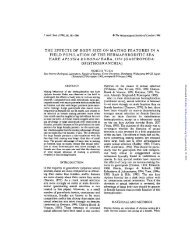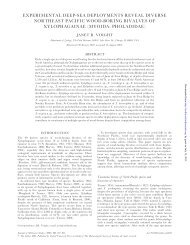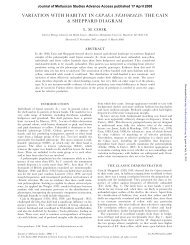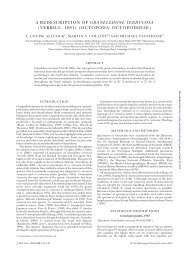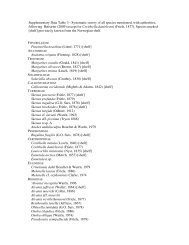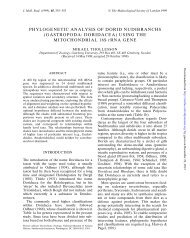the phylogeny and biogeography of the genus zonites - Journal of ...
the phylogeny and biogeography of the genus zonites - Journal of ...
the phylogeny and biogeography of the genus zonites - Journal of ...
You also want an ePaper? Increase the reach of your titles
YUMPU automatically turns print PDFs into web optimized ePapers that Google loves.
<strong>Journal</strong> <strong>of</strong> Molluscan Studies Advance Access published 20 February 2009<br />
THE PHYLOGENY AND BIOGEOGRAPHY OF THE GENUS ZONITES<br />
MONTFORT, 1810 (GASTROPODA: PULMONATA): PRELIMINARY<br />
EVIDENCE FROM MITOCHONDRIAL DATA<br />
PANAGIOTIS KORNILIOS 1 , NIKOS POULAKAKIS 2,3 , MOYSIS MYLONAS 1,2<br />
AND KATERINA VARDINOYANNIS 2<br />
1 Department <strong>of</strong> Biology, University <strong>of</strong> Crete, Vassilika Vouton, PO Box 2208, 71409 Heraklion, Crete, Greece;<br />
2 Natural History Museum <strong>of</strong> Crete, University <strong>of</strong> Crete, Knosos Avenue, PO Box 2208, 71409 Herakleio, Crete, Greece; <strong>and</strong><br />
3 Department <strong>of</strong> Ecology <strong>and</strong> Evolutionary Biology <strong>and</strong> Yale Institute <strong>of</strong> Biospheric Studies, Yale University, New Haven, CT 06520-8106, USA<br />
(Received 6 June 2008; accepted 26 November 2008)<br />
ABSTRACT<br />
The <strong>genus</strong> Zonites, which includes 26 extant species, is distributed in <strong>the</strong> nor<strong>the</strong>astern Mediterranean<br />
area <strong>and</strong> exhibits significant diversity <strong>and</strong> endemism. This is <strong>the</strong> first phylogenetic study <strong>of</strong> Zonites,<br />
based on partial mitochondrial DNA sequences <strong>of</strong> <strong>the</strong> 16S rRNA gene. A total <strong>of</strong> 43 specimens,<br />
belonging to 15 species from 39 localities in Greece <strong>and</strong> Turkey, were included. Analyses revealed<br />
two major clades, corresponding to two distinct geographic regions, west <strong>and</strong> east <strong>of</strong> <strong>the</strong> mid-Aegean<br />
trench. The palaeogeography <strong>of</strong> <strong>the</strong> Aegean <strong>and</strong> <strong>the</strong> plasticity <strong>of</strong> <strong>the</strong> Zonites shells have produced a<br />
great variety <strong>of</strong> forms that have been identified as different species or subspecies. Our results,<br />
although preliminary, suggest that <strong>the</strong> taxonomy <strong>of</strong> Zonites requires revision. We propose an historical<br />
interpretation <strong>of</strong> <strong>the</strong> present distribution <strong>of</strong> Zonites, based on <strong>the</strong> palaeogeographic history <strong>of</strong> <strong>the</strong><br />
Aegean region.<br />
INTRODUCTION<br />
The family Zonitidae is one <strong>of</strong> <strong>the</strong> most species-rich families <strong>of</strong><br />
pulmonates. It is represented in Greece by c. 117 species that<br />
belong to 10 genera (Riedel, 1992): Vitrea, Lindbergia, Gyralina,<br />
Aegopinella, Allaegopis, Doraegopis, Balcanodiscus, Oxychilus,<br />
Eopolita <strong>and</strong> Zonites. The family is diverse in terms <strong>of</strong> its large<br />
number <strong>of</strong> species, <strong>the</strong>ir significant morphological divergence<br />
<strong>and</strong> <strong>the</strong>ir high endemism. The Greek zonitid fauna is a few<br />
times richer than that <strong>of</strong> any o<strong>the</strong>r area <strong>of</strong> similar or greater<br />
size <strong>and</strong> 75% <strong>of</strong> <strong>the</strong> worldwide zonitid species are endemic to<br />
Greece (Riedel, 1992).<br />
The <strong>genus</strong> Zonites Montfort, 1810 includes 28 species, <strong>of</strong><br />
which 25 are found in Greece (seven <strong>of</strong> <strong>the</strong>se also present in<br />
Turkey; 18 exclusively endemic to Greece) (Riedel, 1992;<br />
Riedel & Mylonas, 1995, 1997; Schu¨tt, 2005). Two species<br />
(Z. santoriniensis <strong>and</strong> Z. siphnicus) are extinct <strong>and</strong> found only as<br />
subfossils (Riedel, 1985; Riedel & Mylonas, 1997) (Fig. 1).<br />
Zonites is distributed in <strong>the</strong> nor<strong>the</strong>astern part <strong>of</strong> <strong>the</strong><br />
Mediterranean region. In particular, it is found in central <strong>and</strong><br />
sou<strong>the</strong>rn Peloponnisos (six species), in Evvoia <strong>and</strong> <strong>the</strong> adjacent<br />
coast <strong>of</strong> Attica (two species), in <strong>the</strong> Aegean isl<strong>and</strong>s (15 species,<br />
including <strong>the</strong> two extinct species) <strong>and</strong> in western Turkey (10<br />
species, three <strong>of</strong> which are endemic) (Fig. 1). Zonites is found<br />
only as a fossil in <strong>the</strong> southwestern Kyklades <strong>and</strong> in Crete, <strong>and</strong><br />
is absent from some areas whose malac<strong>of</strong>auna has been<br />
thoroughly studied, such as <strong>the</strong> nor<strong>the</strong>rn Kyklades, Sterea<br />
Ellada <strong>and</strong> some isl<strong>and</strong>s <strong>of</strong> <strong>the</strong> central East Aegean (Riedel,<br />
1992).<br />
Formerly, <strong>the</strong> <strong>genus</strong> Zonites was divided into two subgenera:<br />
Zonites, distributed in Greece <strong>and</strong> western Asia Minor as<br />
already described, <strong>and</strong> Turco<strong>zonites</strong>, distributed in sou<strong>the</strong>astern<br />
Turkey <strong>and</strong> Syria (Riedel, 1987a). These two taxa are now<br />
considered to be distinct genera (Riedel, 1995).<br />
Correspondence: P. Kornilios; e-mail: korniliospan@yahoo.gr<br />
The <strong>genus</strong> Zonites is believed to be <strong>of</strong> eastern origin (Riedel,<br />
1987b) <strong>and</strong> most probably descended from an ancestral form<br />
that was related to Turco<strong>zonites</strong>, since <strong>the</strong> supposedly most basal<br />
Zonites species (Z. osmanicus) occurs at <strong>the</strong> eastern edge <strong>of</strong> <strong>the</strong><br />
range, in Asia Minor (Riedel, 1992).<br />
According to Riedel (1992) <strong>the</strong> diversification <strong>of</strong> Zonites<br />
dates from <strong>the</strong> Neogene, when <strong>the</strong>se snails must have exp<strong>and</strong>ed<br />
from Asia Minor to Evvoia <strong>and</strong> Peloponnisos via <strong>the</strong> Kyklades<br />
bridge (<strong>the</strong> isl<strong>and</strong>s <strong>of</strong> <strong>the</strong> Kyklades complex were at that time<br />
connected above sea level). The numerous species <strong>and</strong> high<br />
endemism <strong>of</strong> Zonites may be explained by palaeogeographic<br />
events that formed <strong>the</strong> present Aegean archipelago during <strong>the</strong><br />
Neogene <strong>and</strong> Pleistocene. The palaeogeographic history <strong>of</strong> this<br />
region is described in detail by Poulakakis et al. (2005a).<br />
During <strong>the</strong> early <strong>and</strong> middle Miocene (23–12 Ma), <strong>the</strong><br />
Aegean was part <strong>of</strong> a continuous l<strong>and</strong>mass known as Agäis. At<br />
12–8 Ma intense tectonic movements probably initiated <strong>the</strong><br />
modern configuration <strong>of</strong> <strong>the</strong> Aegean, causing <strong>the</strong> breaking up<br />
<strong>of</strong> <strong>the</strong> sou<strong>the</strong>rn Aegean l<strong>and</strong>mass. At <strong>the</strong> end <strong>of</strong> <strong>the</strong> middle<br />
Miocene (12 Ma), <strong>the</strong> mid-Aegean trench (east <strong>of</strong> Crete <strong>and</strong><br />
west <strong>of</strong> Kasos–Karpathos) began to form <strong>and</strong> was fully<br />
completed during <strong>the</strong> early late Miocene (c.10–9 Ma). This<br />
phenomenon caused <strong>the</strong> separation <strong>of</strong> western from eastern<br />
Aegean isl<strong>and</strong>s. Crete, which was connected with <strong>the</strong> mainl<strong>and</strong><br />
during <strong>the</strong> Miocene, became an isl<strong>and</strong> 5 Ma, <strong>and</strong> has not<br />
been connected with <strong>the</strong> mainl<strong>and</strong> since <strong>the</strong>n. The central<br />
Aegean isl<strong>and</strong>s were united in a l<strong>and</strong>mass connected to <strong>the</strong><br />
Greek mainl<strong>and</strong> until <strong>the</strong> Pliocene, although <strong>the</strong>y have had no<br />
direct connection with Peloponnisos since <strong>the</strong> late Tortonian<br />
(8 Ma). In <strong>the</strong> late Pleistocene (21,500 year BP), this l<strong>and</strong>mass<br />
(known as <strong>the</strong> Kyklades bridge) had no connection with <strong>the</strong><br />
mainl<strong>and</strong>. The break-up <strong>of</strong> <strong>the</strong> Kyklades plateau into separate<br />
isl<strong>and</strong>s occurred later, at about 11,500 year BP. Kythira was<br />
partly submerged in <strong>the</strong> early Pliocene, <strong>and</strong> did not re-emerge<br />
until <strong>the</strong> late Pliocene (c.2.5 Ma), while in <strong>the</strong> Pleistocene it<br />
was probably an isl<strong>and</strong>, smaller than today, but not as far<br />
from <strong>the</strong> coast (Peloponnisos). Karpathos was connected with<br />
<strong>Journal</strong> <strong>of</strong> Molluscan Studies (2009) 00: 1–9 doi:10.1093/mollus/eyp003<br />
# The Author 2009. Published by Oxford University Press on behalf <strong>of</strong> The Malacological Society <strong>of</strong> London, all rights reserved<br />
Downloaded from<br />
http://mollus.oxfordjournals.org/<br />
by guest on July 15, 2013
<strong>the</strong> Turkish mainl<strong>and</strong> via Rodos during <strong>the</strong> early Pliocene. It<br />
was almost totally submerged during <strong>the</strong> late Pliocene, while<br />
in <strong>the</strong> Pleistocene it re-emerged <strong>and</strong> probably was connected<br />
with Kasos. Rodos remained connected with <strong>the</strong> Turkish<br />
mainl<strong>and</strong> until <strong>the</strong> early Pleistocene, when it was finally isolated.<br />
Finally, <strong>the</strong> isolation <strong>of</strong> <strong>the</strong> eastern Aegean isl<strong>and</strong>s (e.g.<br />
Samos, Lesvos, Chios) from <strong>the</strong> Turkish mainl<strong>and</strong> occurred<br />
during <strong>the</strong> late Pleistocene or Holocene (data from<br />
Creutzburg, 1963; Daams & Van der Weerd, 1980;<br />
Dermitzakis & Papanikolaou, 1981; Meulenkamp, 1985; Boger<br />
& Dermitzakis, 1985; Dermitzakis, 1990; Sondaar, et al., 1998;<br />
Perissoratis & Conispoliatis, 2003).<br />
The systematics <strong>of</strong> Zonites is based on external (shell) <strong>and</strong><br />
internal (genitalia) morphology. Some <strong>of</strong> <strong>the</strong> currently recognized<br />
species show significant morphological variation; some<br />
individuals, assigned morphologically to a certain species, also<br />
bear characteristics <strong>of</strong> o<strong>the</strong>r species (e.g. Z. graecus comprises<br />
forms that resemble Z. kobelti or Z. messenicus on Peloponnisos,<br />
while some individuals identified as Z. messenicus bear characters<br />
<strong>of</strong> Z. graecus <strong>and</strong>, as Riedel (1992) states, Z. messenicus could be<br />
considered a subspecies <strong>of</strong> Z. graecus). The nomenclature <strong>of</strong><br />
several species has been changed on many occasions in <strong>the</strong> past<br />
<strong>and</strong> Riedel (1992) has pointed out <strong>the</strong> need for fur<strong>the</strong>r studies<br />
on <strong>the</strong>ir <strong>biogeography</strong>, systematics <strong>and</strong> nomenclature.<br />
Although numerous studies have used morphological characters<br />
to establish taxonomy <strong>and</strong> to propose phylogenetic<br />
relationships <strong>of</strong> terrestrial gastropods in <strong>the</strong> past, in many cases<br />
<strong>the</strong>ir remarkable phenotypic diversity has led to controversial<br />
systematics. Mitochondrial <strong>and</strong> nuclear genetic markers are<br />
now widely used to study stylommatophoran <strong>phylogeny</strong> (e.g.<br />
Douris et al., 1995; Parmakelis et al., 2003; Steinke, Albrecht &<br />
Pfenninger, 2004; Parmakelis et al., 2005; Pinceel, Jordaens &<br />
Backeljau, 2005; Ketmaier, Giusti & Caccone, 2006;<br />
Pfenninger, Cordellier & Streit, 2006; Douris et al., 2007). Some<br />
<strong>of</strong> <strong>the</strong>se studies suggest that shell morphology alone is a poor<br />
P. KORNILIOS ET AL.<br />
Figure 1. Map showing distribution <strong>of</strong> <strong>the</strong> <strong>genus</strong> Zonites, sampling localities (map codes are reported in Appendix) <strong>and</strong> several important regions<br />
<strong>and</strong> isl<strong>and</strong>s mentioned in text.<br />
2<br />
guide to taxonomy, because shell variation is <strong>of</strong>ten continuous<br />
or overlapping, <strong>and</strong> shells may be phenotypically plastic<br />
(Steinke et al., 2004; Ketmaier et al., 2006; Pfenninger et al.,<br />
2006). Therefore, studies combining traditional taxonomy with<br />
DNA-based results are needed (Pfenninger et al., 2006).<br />
Despite <strong>the</strong> diversity <strong>and</strong> endemism <strong>of</strong> Zonites, little work has<br />
been done on its <strong>phylogeny</strong> <strong>and</strong> phylogeography. Never<strong>the</strong>less,<br />
terrestrial molluscs can be particularly informative in studies <strong>of</strong><br />
<strong>the</strong> <strong>biogeography</strong> <strong>of</strong> isl<strong>and</strong>s, such as <strong>the</strong> Aegean archipelago<br />
with its complex palaeogeographic history (Mylonas, 1982;<br />
Riedel, 1992; Riedel & Mylonas, 1995).<br />
This preliminary study is <strong>the</strong> first phylogenetic approach to<br />
<strong>the</strong> <strong>genus</strong> Zonites, <strong>and</strong> includes c. 65% <strong>of</strong> <strong>the</strong> extant Zonites<br />
species found in Greece. Since only a relatively small fragment<br />
<strong>of</strong> a single mitochondrial molecular marker (16S rRNA) was<br />
analysed, this data set does not permit definitive conclusions or<br />
support taxonomic revision. However, it serves our two aims <strong>of</strong><br />
testing whe<strong>the</strong>r <strong>the</strong> genetic relationships agree with <strong>the</strong> current<br />
morphology-based taxonomy, <strong>and</strong> proposing a hypo<strong>the</strong>tical<br />
biogeographic scenario to explain <strong>the</strong> present geographic<br />
distribution.<br />
MATERIAL AND METHODS<br />
Sampling <strong>of</strong> taxa<br />
A fragment <strong>of</strong> <strong>the</strong> 16S gene was sequenced from 43 individuals<br />
<strong>of</strong> Zonites. Two individuals <strong>of</strong> <strong>the</strong> <strong>genus</strong> Turco<strong>zonites</strong> were used<br />
as outgroup. All sequences were obtained from museum<br />
samples, deposited in <strong>the</strong> Natural History Museum <strong>of</strong> Crete,<br />
preserved in 75% alcohol. The sampling localities are shown<br />
in Figure 1 <strong>and</strong> <strong>the</strong> specimens are listed in <strong>the</strong> Appendix. The<br />
identification <strong>of</strong> species <strong>and</strong> subspecies was based on shell morphology<br />
<strong>and</strong> <strong>the</strong> anatomy <strong>of</strong> <strong>the</strong> genitalia (Riedel, 1987a,<br />
1987b, 1992, 1995; Riedel & Mylonas, 1995, 1997).<br />
Downloaded from<br />
http://mollus.oxfordjournals.org/ by guest on July 15, 2013
DNA extraction <strong>and</strong> amplification<br />
Total genomic DNA was extracted from foot tissue (tail tip).<br />
After homogenization, <strong>the</strong> Macherey–Nagel NucleoSpin<br />
Tissue DNA extraction kit was used.<br />
Using <strong>the</strong> universal primers 16Sar-L <strong>and</strong> 16Sbr-H (Palumbi<br />
et al., 1991), we amplified a c. 500-bp segment <strong>of</strong> <strong>the</strong> 16S<br />
rRNA gene (primary PCR). The amplification <strong>of</strong> DNA from<br />
samples preserved in 75% alcohol is a difficult procedure, due<br />
to DNA damage. Because none <strong>of</strong> <strong>the</strong> specimens produced a<br />
visible PCR product in agarose gel (1%) stained with EtBr, we<br />
applied a nested PCR. With a pair <strong>of</strong> internal primers, PyrFor<br />
(5 0 -GCGGCAGTACATTGACTGTGC-3 0 ) <strong>and</strong> PyrRev1<br />
(5 0 -GCCTTAATCCAACATCGAGGT-3 0 ), whose design was<br />
based on published l<strong>and</strong>-snail sequences, we performed a secondary<br />
PCR using <strong>the</strong> primary PCR product as template. In<br />
this way we amplified a segment <strong>of</strong> c. 310 bp <strong>of</strong> <strong>the</strong> 16S rRNA<br />
gene. PCR conditions for both pairs <strong>of</strong> primers involved an<br />
initial cycle <strong>of</strong> denaturation at 948C for 5 min, <strong>and</strong> 40 subsequent<br />
cycles <strong>of</strong> 948C for 1 min, 428C for 1 min <strong>and</strong> 728C for<br />
1 min, in <strong>the</strong> presence <strong>of</strong> 1.5 mM MgCl2.<br />
Purification <strong>and</strong> sequencing<br />
PCR products were purified with <strong>the</strong> Macherey–Nagel<br />
NucleoSpin Extract II DNA purification kit. Sequencing was<br />
conducted on an ABI PRISM automated sequencer using <strong>the</strong><br />
Big-Dye Terminator (v. 3.1) Cycle Sequencing kit <strong>and</strong> <strong>the</strong> PCR<br />
primers. Both forward <strong>and</strong> reverse str<strong>and</strong>s <strong>of</strong> <strong>the</strong> PCR product<br />
were sequenced. We performed an NCBI-BLAST search (http://<br />
blast.ncbi.nlm.nih.gov/) to confirm that <strong>the</strong> obtained sequences<br />
belonged to pulmonate molluscan 16S rRNA.<br />
Alignment <strong>and</strong> genetic divergence<br />
DNA sequences were aligned using CLUSTAL X (Thompson,<br />
Higgins & Gibson, 1994) <strong>and</strong> adjusted by eye. All DNA<br />
sequences are deposited in GenBank (accession numbers:<br />
EF568962–EF569006).<br />
Distance-based genetic divergences were estimated in<br />
MEGA v. 2 (Kumar, Tamura & Nei, 2004) using <strong>the</strong> Kimura<br />
2-parameter model (Kimura, 1981).<br />
Phylogenetic analyses<br />
Three methods were used to conduct <strong>the</strong> phylogenetic analyses:<br />
Neighbour-Joining (NJ), Maximum Likelihood (ML)<br />
<strong>and</strong> Bayesian inference (BI).<br />
The selection <strong>of</strong> <strong>the</strong> most suitable model <strong>of</strong> DNA substitution<br />
for <strong>the</strong> ML <strong>and</strong> BI analyses was done using Modeltest<br />
3.7 (Posada & Cr<strong>and</strong>all, 1998), under <strong>the</strong> Akaike Information<br />
Criterion (AIC; Akaike, 1974). The best-fit model was K81 þ<br />
G (Kimura, 1981) (model parameters: ln L ¼ 21855.670, K ¼<br />
93, Rmatrix A/C ¼ 1.00, A/G ¼ 5.37, A/T ¼ 1.97, C/G ¼<br />
1.97, C/T ¼ 5.37, G/T ¼ 1.00, a ¼ 0.41).<br />
NJ analysis was performed with PAUP* (v. 4.0 b10;<br />
Sw<strong>of</strong>ford, 2002), with 1000 bootstrap replicates to estimate<br />
statistical support values (Felsenstein, 1985).<br />
ML analyses (Felsenstein, 1981) were conducted using<br />
PAUP* <strong>and</strong> GARLI v. 0.95 (Zwickl, 2006). In PAUP*, heuristic<br />
ML searches were performed with 10 replicates <strong>of</strong> r<strong>and</strong>om<br />
sequence addition <strong>and</strong> TBR branch swapping, based on <strong>the</strong><br />
successive-approximations strategy <strong>of</strong> Sw<strong>of</strong>ford et al. (1996) <strong>and</strong><br />
Sullivan et al. (2005). In GARLI, heuristic ML searches were<br />
performed with 10 5 replicates <strong>of</strong> r<strong>and</strong>om sequence addition<br />
using <strong>the</strong> GARLI algorithm. Since a ML tree search with such<br />
a complex model would be computationally excessive in<br />
PHYLOGENY OF ZONITES<br />
3<br />
PAUP*, <strong>the</strong> confidence <strong>of</strong> <strong>the</strong> nodes was assessed only in<br />
GARLI based on 1000 bootstrap replicates.<br />
The Bayesian analysis was performed in MrBayes (v. 3.1;<br />
Ronquist & Huelsenbeck, 2003) with two runs <strong>and</strong> eight<br />
chains for each run, for 10 7 generations <strong>and</strong> <strong>the</strong> current tree<br />
was saved every 100 generations. This generated an output <strong>of</strong><br />
10 10 4 trees. Stationarity was reached, both in terms <strong>of</strong> likelihood<br />
scores <strong>and</strong> parameter estimation, after c. 10 6 generations<br />
<strong>and</strong> <strong>the</strong> first 10 4 trees (10% ‘burn-in’ in Bayesian terms) were<br />
discarded as a conservative measure to avoid <strong>the</strong> possibility <strong>of</strong><br />
including r<strong>and</strong>om, sub-optimal trees. During tree search, full<br />
parameter estimation was performed, <strong>and</strong> <strong>the</strong> posterior probabilities<br />
were calculated as <strong>the</strong> percentage <strong>of</strong> samples recovering<br />
any particular clade (Huelsenbeck & Ronquist, 2001),<br />
where probabilities 95% indicate significant support. Two<br />
fur<strong>the</strong>r independent Bayesian analyses were run so that global<br />
likelihood scores, individual parameter values, topology <strong>and</strong><br />
nodal support could be compared to check for local optima.<br />
Testing alternative hypo<strong>the</strong>ses<br />
We tested two explicit hypo<strong>the</strong>ses: (1) <strong>the</strong> monophyly <strong>of</strong><br />
Z. pergranulatus <strong>and</strong> (2) <strong>the</strong> monophyly <strong>of</strong> <strong>the</strong> species groups to<br />
<strong>the</strong> east <strong>and</strong> west <strong>of</strong> <strong>the</strong> mid-Aegean trench (Fig. 3). The corresponding<br />
hypo<strong>the</strong>tical trees (a tree constrained to be monophyletic<br />
for Z. pergranulatus <strong>and</strong> a tree constrained to be<br />
monophyletic for <strong>the</strong> species east <strong>of</strong> <strong>the</strong> mid-Aegean trench)<br />
were generated with PAUP* under <strong>the</strong> likelihood criterion,<br />
<strong>and</strong> compared with our optimal topology using <strong>the</strong><br />
Shimodaira–Hasegawa (SH) test (Shimodaira & Hasegawa,<br />
1999) as implemented in PAUP* <strong>and</strong> employing RELL bootstrap<br />
with 1000 replicates.<br />
Calibration <strong>of</strong> molecular clock <strong>and</strong> estimation <strong>of</strong> divergence times<br />
A log-likelihood ratio test (LRT) was used to examine <strong>the</strong><br />
clock-like evolution <strong>of</strong> sequences <strong>of</strong> <strong>the</strong> ingroup by calculating<br />
a x 2 statistic (LRT) based on ML values with <strong>and</strong> without<br />
rate constancy enforced (x 2 ¼ 2 [(2ln LCLOCK) 2 (2ln<br />
LUNCONSTRAINED)], df ¼ number <strong>of</strong> terminal nodes 2 2)<br />
(Felsenstein, 1981). The divergence times <strong>of</strong> Zonites lineages<br />
were estimated in <strong>the</strong> s<strong>of</strong>tware r8s (v. 1.7.1) (S<strong>and</strong>erson, 1997,<br />
2002) with <strong>the</strong> recommended Powell algorithm using <strong>the</strong><br />
Langley–Fitch method (LF), which uses ML to reconstruct<br />
divergence times under <strong>the</strong> assumption <strong>of</strong> a molecular clock,<br />
since this hypo<strong>the</strong>sis was not rejected. To estimate substitution<br />
rates, we used a single calibration point based on <strong>the</strong> assumption<br />
that divergence between Z. festai from Rodos <strong>and</strong> Z. casius<br />
from Kasos began 3.5 Ma (enforcement <strong>of</strong> maximum age constraint<br />
on that node), soon after <strong>the</strong> separation <strong>of</strong> <strong>the</strong> Kasos–<br />
Karpathos isl<strong>and</strong> group from <strong>the</strong> isl<strong>and</strong> <strong>of</strong> Rodos, which took<br />
place 3–3.5 Ma (Daams & Van der Weerd, 1980). These<br />
monophyletic lineages are suitable for this calibration, as <strong>the</strong>y<br />
form sister clades with low intra-specific variability. Factors<br />
that could affect clock calibrations include stochastic variation<br />
at low levels <strong>of</strong> sequence divergence <strong>and</strong> <strong>the</strong> possibility <strong>of</strong><br />
extinct or unsampled lineages (Emerson, Oromı´ & Hewitt<br />
2000; Emerson, 2002). The separation <strong>of</strong> <strong>the</strong> Kasos–Karpathos<br />
isl<strong>and</strong> group from <strong>the</strong> isl<strong>and</strong> <strong>of</strong> Rodos has been successfully<br />
used as a reliable calibration point in <strong>the</strong> past (Poulakakis<br />
et al., 2005a).<br />
RESULTS<br />
Polymorphisms <strong>and</strong> genetic divergence<br />
The 16S segment provided 310 bp, containing 150 variable<br />
sites (48.4%), 137 <strong>of</strong> which (44.2%) were parsimony-<br />
Downloaded from<br />
http://mollus.oxfordjournals.org/ by guest on July 15, 2013
Table 1. Average genetic divergences (%), based on <strong>the</strong> Kimura 2-parameter model (Kimura, 1981), within (bold text) <strong>and</strong> between <strong>the</strong><br />
geographical groups.<br />
informative. Excluding <strong>the</strong> outgroup, <strong>the</strong>re were 129 (41.6%)<br />
variable sites, <strong>of</strong> which 116 were parsimony-informative<br />
(37.4%). The mean values <strong>of</strong> A, T, G <strong>and</strong> C, within <strong>the</strong><br />
ingroup, are 38.2%, 34.2%, 16.8% <strong>and</strong> 10.7%, respectively.<br />
Genetic divergences varied from 0% (individuals <strong>of</strong> <strong>the</strong><br />
same species <strong>and</strong> <strong>of</strong> adjacent localities) to 45.7% between individuals<br />
<strong>of</strong> remote localities (within <strong>the</strong> ingroup). The mean<br />
value <strong>of</strong> <strong>the</strong> genetic divergences was 22.2%. The genetic divergence<br />
values within <strong>and</strong> between <strong>the</strong> groups defined according<br />
to <strong>the</strong>ir geographic <strong>and</strong> taxonomic status are shown in<br />
Table 1. Within <strong>the</strong> groups <strong>the</strong> divergences vary from 0% to<br />
2.4% (within <strong>the</strong> Z. pergranulatus pergranulatus group which<br />
includes individuals from four different Aegean isl<strong>and</strong>s), while<br />
between <strong>the</strong> groups, <strong>the</strong> smallest divergence is that between<br />
<strong>the</strong> Z. rhodius martensi <strong>and</strong> <strong>the</strong> Z. r. elatior groups (1.2%) <strong>and</strong><br />
<strong>the</strong> largest one is that between <strong>the</strong> Z. smyrnensis group <strong>and</strong> <strong>the</strong><br />
group including all Peloponnesian species (40.4%).<br />
Phylogenetic tree topology<br />
All three phylogenetic analyses produced trees <strong>of</strong> <strong>the</strong> same topology<br />
(Fig. 2). A geographic presentation <strong>of</strong> <strong>the</strong> phylogenetic<br />
affinities is shown in Figure 3. ML analyses resulted in <strong>the</strong><br />
same topology with ln L ¼ 21848.248 <strong>and</strong> 21849.765 in<br />
GARLI <strong>and</strong> PAUP*, respectively, while Bayesian inference<br />
resulted in a topology with mean ln L ¼ 21933.843. Both runs<br />
<strong>of</strong> <strong>the</strong> Bayesian inference produced identical consensus trees<br />
<strong>and</strong> <strong>the</strong> 50% majority-rule consensus tree <strong>of</strong> all trees remaining<br />
after burn-in is presented in Figure 3. Zonites appears to split<br />
into two major clades: most <strong>of</strong> <strong>the</strong> Zonites individuals from <strong>the</strong><br />
eastern sampling localities (Turkey <strong>and</strong> <strong>the</strong> eastern Aegean<br />
isl<strong>and</strong>s) are included in clade A, while clade B includes<br />
mainly <strong>the</strong> individuals from mainl<strong>and</strong> Greece <strong>and</strong> <strong>the</strong> central<br />
Aegean isl<strong>and</strong>s. The support values for <strong>the</strong>se main clades (NJ<br />
bootstrap value/ML bootstrap value/BI posterior probability)<br />
are, respectively, 62/55/0.81 for clade A <strong>and</strong> 91/77/1.00 for<br />
clade B.<br />
Clade B is subdivided into two subclades, B1 <strong>and</strong> B2, which<br />
comprise specimens from continental Greece (Evvoia,<br />
Peloponnisos, Kythira) along with Lesvos (a case <strong>of</strong> human<br />
dispersal), <strong>and</strong> from <strong>the</strong> Aegean isl<strong>and</strong>s, respectively. The<br />
respective support values are 85/76/0.80 <strong>and</strong> 79/64/0.90.<br />
Finally, two main lineages are present in <strong>the</strong> isl<strong>and</strong>s <strong>of</strong> subclade<br />
B2: lineage B2.1 (Karpathos, Kasos, Naxos, Amorgos,<br />
P. KORNILIOS ET AL.<br />
1 2 3 4 5 6 7 8 9 10 11 12 13 14<br />
1. Chios, Turkey (Z. chl) 2.2<br />
2. Chios, Samos (Z.smy) 20.8 1.9<br />
3. Rodos (Z fes) 24.8 23.3 0<br />
4. Kasos (Z.cas) 24.7 22.9 2.7 0.4<br />
5. Kastelorizo (Z.car) 22.3 24.6 10.2 11.2 0.2<br />
6. Karpathos (Z.r.m) 39.4 37.9 27.6 29.9 27.2 0.7<br />
7. Kasos (Z.r.e) 39.3 38.5 26.5 28.7 25.5 1.2 0<br />
8. Naxos, Amorgos, Kinaros, Levitha (Z.p.p) 36.5 39.2 30.4 30.7 29.0 7.2 7.4 2.4<br />
9. Astypalaia, Astakida (Z.p.c & Z.ast) 32.1 35.6 34.6 35.0 31.4 17.0 15.7 19.7 0.9<br />
10. Anafi (Z.ana) 27.8 33.6 29.8 30.2 28.4 11.3 10.3 13.8 3.8 0<br />
11. Kythira (Z.alg. & Z.par) 35.8 37.3 23.3 25.4 27.2 16.7 16.7 17.7 17.6 16.6 0.3<br />
12. Peloponnisos (Z.gra, Z kob & Z mes) 33.6 40.4 28.9 31.5 31.1 22.5 23.6 21.7 26.9 21.2 10.9 1.8<br />
13. Evvoia (Z.oer) 32.2 38.3 19.7 21.2 23.3 19.8 19.9 19.5 19.1 15.3 11.0 10.8 0<br />
14. Syria (Tur) 41.1 49.3 36.6 35.4 37.5 40.5 38.0 37.7 52.2 43.2 41.6 42.8 37.3 0<br />
Maximum <strong>and</strong> minimum values between <strong>the</strong> groups are italicized. Species abbreviations are shown in <strong>the</strong> Appendix.<br />
4<br />
Kinaros, Levitha) <strong>and</strong> lineage B2.2 (Anafi, Astipalea,<br />
Astakida) (92/57/0.98 <strong>and</strong> 99/94/1.00, respectively).<br />
The SH test rejects <strong>the</strong> hypo<strong>the</strong>ses that Z. pergranulatus is a<br />
monophyletic taxon (P . 0.05), <strong>and</strong> that <strong>the</strong> species distributed<br />
east <strong>and</strong> west <strong>of</strong> <strong>the</strong> mid-Aegean trench form monophyletic<br />
groups (P . 0.05).<br />
The existence <strong>of</strong> a uniform molecular clock implying <strong>the</strong><br />
homogeneity <strong>of</strong> evolutionary rates was tested with <strong>the</strong> LRT by<br />
calculating a x 2 statistic. This test did not reject <strong>the</strong> null<br />
hypo<strong>the</strong>sis <strong>of</strong> a homogeneous clock-like rate for <strong>the</strong> tree produced<br />
by <strong>the</strong> Zonites sequences from <strong>the</strong> Aegean region<br />
(LRT ¼ 2*[1871.03 2 1849.76] ¼ 42.54, df ¼ 43, a ¼ 0.05,<br />
xcritical ¼ 59.30 <strong>and</strong> P , 0.0001), assuming clock-like evolution<br />
<strong>of</strong> <strong>the</strong> involved sequences. According to <strong>the</strong> calibration reference<br />
point, <strong>the</strong> diversification <strong>of</strong> <strong>the</strong> lineages <strong>of</strong> Zonites included<br />
in this study occurred at c. 11.7 Ma, during <strong>the</strong> late Miocene<br />
(Fig. 2).<br />
DISCUSSION<br />
Polymorphism <strong>and</strong> genetic divergence<br />
The 16S rRNA gene is considered a relatively conserved region<br />
<strong>of</strong> <strong>the</strong> mitochondrial DNA. Numerous studies in <strong>the</strong> past have<br />
shown that l<strong>and</strong> snails exhibit great levels <strong>of</strong> mitochondrial<br />
diversity, even for this relatively slowly evolving gene (Douris<br />
et al., 1995; Thomaz, Guiller & Clarke, 1996; Parmakelis et al.,<br />
2003, 2005). In our case, <strong>the</strong> genetic divergences among Zonites<br />
specimens are extremely high (mean 22.2%, maximum<br />
40.4%). However, given <strong>the</strong> relative small size <strong>of</strong> <strong>the</strong> 16S gene<br />
segment analysed, <strong>the</strong>se diversity <strong>and</strong> divergence estimates<br />
may be biased, particularly since rRNA genes comprise both<br />
conserved <strong>and</strong> rapidly evolving regions (Smit, Widmann &<br />
Knight, 2007).<br />
Phylogenetic relationships <strong>and</strong> systematics<br />
The molecular phylogenetic hypo<strong>the</strong>sis agrees to some extent<br />
with <strong>the</strong> current taxonomy <strong>of</strong> <strong>the</strong> <strong>genus</strong> based on morphological<br />
characters. In most cases, specimens <strong>of</strong> <strong>the</strong> same species<br />
group toge<strong>the</strong>r, even if sampled from different regions or<br />
isl<strong>and</strong>s (e.g. Z. pergranulatus pergranulatus from Naxos, Amorgos,<br />
Kinaros <strong>and</strong> Levitha; Z. algirus from Kythira <strong>and</strong> Lesvos;<br />
Z. graecus from distant localities <strong>of</strong> Peloponnisos; Z. chloroticus<br />
from Chios <strong>and</strong> Turkey; Z. smyrnensis from Samos <strong>and</strong> Chios).<br />
Downloaded from<br />
http://mollus.oxfordjournals.org/ by guest on July 15, 2013
Figure 2. Tree summarizing phylogenetic relationships among <strong>the</strong> 45 individuals studied with <strong>the</strong> <strong>genus</strong> Turco<strong>zonites</strong> from Syria as outgroup. The<br />
tree presented is <strong>the</strong> one produced from <strong>the</strong> BI analysis (all methods <strong>of</strong> analysis, NJ, ML <strong>and</strong> BI, produced trees <strong>of</strong> <strong>the</strong> same topology). Bootstrap<br />
values <strong>of</strong> NJ/ML analyses are shown, respectively, above branches, <strong>and</strong> posterior probabilities <strong>of</strong> BI are below branches. The numbers by some<br />
internal nodes (with relative high statistical support), highlighted with a small circle, indicate age <strong>of</strong> that node in millions <strong>of</strong> years.<br />
On <strong>the</strong> o<strong>the</strong>r h<strong>and</strong>, some forms that have been morphologically<br />
identified as different species group toge<strong>the</strong>r <strong>and</strong> exhibit<br />
such small genetic divergence values that <strong>the</strong> validity <strong>of</strong> <strong>the</strong>se<br />
species is questionable. As seen in Figures 2 <strong>and</strong> 3, <strong>the</strong> lineage<br />
from Peloponnisos (B1 subclade) includes three species that form<br />
a group with low intra-specific divergence (1.8%) compared<br />
with <strong>the</strong> mean value <strong>of</strong> <strong>the</strong> ingroup (22.2%). This result agrees<br />
with <strong>the</strong> observations that <strong>the</strong>se species (Z. graecus, Z. kobelti,<br />
Z. messenicus) present forms with intermediate morphological<br />
characteristics <strong>and</strong> that Z. messenicus could be considered a subspecies<br />
<strong>of</strong> Z. graecus (Riedel, 1992). The genetic divergence<br />
between Z. parnonensis <strong>and</strong> Z. algirus from Kythira is also small<br />
(0.3%), as are those between Z. pergranulatus cycladicus<br />
(Astypalaia) <strong>and</strong> Z. astakidae (Astakida) (0.9%) <strong>and</strong> between<br />
Z. anaphiensis (Anafi) <strong>and</strong> Z. p. cycladicus/Z. astakidae (2.4%). In<br />
PHYLOGENY OF ZONITES<br />
5<br />
<strong>the</strong> latter cases, <strong>the</strong> morphological differentiation is not reflected<br />
at <strong>the</strong> genetic level, at least as shown in our molecular data.<br />
As seen on subclade B2 (Figs 2 <strong>and</strong> 3), individuals <strong>of</strong><br />
Z. pergranulatus pergranulatus (Naxos, Amorgos, Kinaros,<br />
Levitha) are more closely related to individuals <strong>of</strong> Z. rhodius<br />
(genetic divergence: 7.3%) than <strong>the</strong>y are to <strong>the</strong> conspecific<br />
Z. p. cycladicus (Astypalaia) (19.7%). A highly significant result<br />
<strong>of</strong> <strong>the</strong> SH test fur<strong>the</strong>r rejects <strong>the</strong> hypo<strong>the</strong>sis <strong>of</strong> monophyly <strong>of</strong><br />
Z. pergranulatus in favour <strong>of</strong> <strong>the</strong> topology <strong>of</strong> Figure 2. In o<strong>the</strong>r<br />
words, Z. pergranulatus seems to be polyphyletic, suggesting<br />
that two (cryptic) species may be involved.<br />
Although preliminary, our results suggest that revision <strong>of</strong> <strong>the</strong><br />
current taxonomy <strong>of</strong> <strong>the</strong> <strong>genus</strong> Zonites is needed, since <strong>the</strong>re<br />
are many inconsistencies between <strong>the</strong> molecular <strong>and</strong> <strong>the</strong> morphological<br />
groupings.<br />
Downloaded from<br />
http://mollus.oxfordjournals.org/ by guest on July 15, 2013
Figure 3. A geographical interpretation <strong>of</strong> <strong>the</strong> phylogenetic affinities among Zonites species. The mid-Aegean trench is shown as a thick dashed<br />
line. The main clades <strong>of</strong> <strong>the</strong> phylogenetic tree are indicated. Long-distance affinities are indicated by narrow dashed lines.<br />
Phylogeography<br />
The tree topology suggests that <strong>the</strong> <strong>genus</strong> Zonites follows a phylogeographical<br />
pattern (Figs 2 <strong>and</strong> 3) that is consistent with<br />
<strong>the</strong> palaeogeographic history <strong>of</strong> <strong>the</strong> Aegean area.<br />
The phylogenetic analysis identifies two major clades,<br />
although it should be noted that one <strong>of</strong> <strong>the</strong>m (Clade A) exhibits<br />
low statistical support (Fig. 2). These two clades, A <strong>and</strong> B,<br />
indicate two major lineages within Zonites <strong>and</strong> correspond to<br />
two separate geographical areas (Fig. 3); <strong>the</strong>y include species<br />
from <strong>the</strong> east Aegean <strong>and</strong> from <strong>the</strong> west, respectively.<br />
Although <strong>the</strong> low bootstrap values <strong>of</strong> <strong>the</strong> eastern Clade A call<br />
for cautious conclusions, we can hypo<strong>the</strong>size that behind <strong>the</strong><br />
existence <strong>of</strong> <strong>the</strong>se two clades lies a major palaeogeographical<br />
event, <strong>the</strong> formation <strong>of</strong> <strong>the</strong> Mid-Aegean trench at 12–8 Ma.<br />
This isolated <strong>the</strong> faunas <strong>of</strong> eastern <strong>and</strong> western Aegean isl<strong>and</strong>s,<br />
<strong>and</strong> <strong>the</strong> genetic imprint has been found in phylogeographical<br />
studies <strong>of</strong> many taxa, e.g. reptiles (Poulakakis et al., 2003,<br />
2005a, b, c), l<strong>and</strong> snails (Parmakelis et al., 2005), Coleoptera<br />
(Fattorini, 2002) <strong>and</strong> scorpions (Parmakelis et al., 2006).<br />
We suggest that <strong>the</strong> formation <strong>of</strong> <strong>the</strong> mid-Aegean trench was<br />
also <strong>the</strong> cause <strong>of</strong> <strong>the</strong> separation <strong>of</strong> <strong>the</strong> putative eastern Clade A<br />
<strong>and</strong> <strong>the</strong> western Clade B which, according to our molecular<br />
clock data, began to diverge c. 11.7 Ma, in agreement with <strong>the</strong><br />
palaeogeographical data.<br />
The western Clade B is subdivided into subclade B1<br />
(Peloponnisos, Kythira, Evvoia, Lesvos) <strong>and</strong> subclade B2<br />
(Aegean isl<strong>and</strong>s) (Figs 2 <strong>and</strong> 3). This separation, which seems<br />
to have taken place some 7.9 Ma, reflects <strong>the</strong> isolation <strong>of</strong> isl<strong>and</strong><br />
Zonites taxa from those <strong>of</strong> <strong>the</strong> Peloponnesian mainl<strong>and</strong>, which<br />
must have occurred in <strong>the</strong> late Tortonian (8 Ma) (Dermitzakis<br />
& Papanikolaou, 1981).<br />
There are two possible biogeographic scenarios to explain<br />
<strong>the</strong> existence <strong>of</strong> Zonites in Evvoia <strong>and</strong> Peloponnisos (Fig. 1).<br />
The first suggests that <strong>the</strong> ancestral Zonites form dispersed via<br />
P. KORNILIOS ET AL.<br />
6<br />
<strong>the</strong> Kyklades l<strong>and</strong> bridge <strong>of</strong> <strong>the</strong> central Aegean to <strong>the</strong> Greek<br />
mainl<strong>and</strong>, <strong>and</strong> later colonized Evvoia <strong>and</strong> Peloponnisos. The<br />
second assumes that this <strong>genus</strong> reached Peloponnisos <strong>and</strong><br />
Evvoia by two different pathways, through Crete <strong>and</strong> <strong>the</strong><br />
Kyklades bridge respectively. Our results show that Z. oertzeni<br />
from Evvoia is grouped with <strong>the</strong> Peloponnesian species. This<br />
implies a more recent common ancestry <strong>of</strong> <strong>the</strong> species from<br />
Evvoia <strong>and</strong> Peloponnisos, possibly supporting <strong>the</strong> first biogeographic<br />
scenario. Hence, we assume that Zonites inhabited<br />
Sterea Ellada (Fig. 1) in <strong>the</strong> past <strong>and</strong> later disappeared from<br />
this region. It should be noted that although sou<strong>the</strong>astern continental<br />
Greece has been thoroughly studied, no Zonites representatives<br />
(living, subfossil or fossil) are known from this area<br />
(field observations <strong>of</strong> co-authors).<br />
Finally, <strong>the</strong> grouping <strong>of</strong> <strong>the</strong> isl<strong>and</strong> <strong>of</strong> Kythira with<br />
Peloponnisos also reflects its palaeogeographical history, since<br />
it was partly submerged in <strong>the</strong> Early Pliocene, <strong>and</strong> did not<br />
re-emerge until <strong>the</strong> Late Pliocene (about 2.5 Ma;<br />
Meulenkamp, 1985). During <strong>the</strong> Pleistocene it was probably<br />
an isl<strong>and</strong>, smaller than today, but quite close to <strong>the</strong> coast<br />
(Peloponnisos) (Dermitzakis, 1990). The presence <strong>of</strong> Z. algirus<br />
from Lesvos (an isl<strong>and</strong> near <strong>the</strong> north coast <strong>of</strong> Asia Minor) in<br />
<strong>the</strong> clade <strong>of</strong> Z. algirus from Kythira, is also expected. Zonites<br />
l<strong>and</strong> snails are not edible, <strong>and</strong> <strong>the</strong>refore have no commercial<br />
interest. Never<strong>the</strong>less, Z. algirus, which most likely originated<br />
from sou<strong>the</strong>rn Peloponnisos, is <strong>the</strong> one species <strong>of</strong> <strong>the</strong> <strong>genus</strong> that<br />
has been dispersed by humans. It has been introduced into<br />
Lesvos, Turkey, sou<strong>the</strong>rn France <strong>and</strong> western Greece (Riedel,<br />
1992; O¨ rstan, 2003).<br />
The o<strong>the</strong>r major subclade B2 is also subdivided into<br />
lineages, B2.1 <strong>and</strong> B2.2 (Figs 2 <strong>and</strong> 3). This split took place c.<br />
5.7 Ma. Lineage B2.2 includes Z. pergranulatus cycladicus,<br />
Z. astakidae <strong>and</strong> Z. anaphiensis from Amorgos, Astakida <strong>and</strong><br />
Anafi respectively. These three isl<strong>and</strong>s are located between <strong>the</strong><br />
Downloaded from<br />
http://mollus.oxfordjournals.org/ by guest on July 15, 2013
central Aegean isl<strong>and</strong>s (west <strong>of</strong> <strong>the</strong> mid-Aegean trench)<br />
<strong>and</strong> Kasos-Karpathos (east <strong>of</strong> <strong>the</strong> mid-Aegean trench).<br />
Unexpectedly, <strong>the</strong>se taxa are not joined directly with <strong>the</strong> specimens<br />
from <strong>the</strong> o<strong>the</strong>r Kyklades isl<strong>and</strong>s (Naxos, Amorgos,<br />
Levithta <strong>and</strong> Kinaros) (genetic divergence: 19.7%); instead<br />
<strong>the</strong> latter taxa are joined first with <strong>the</strong> specimens <strong>of</strong> Z. rhodius<br />
from Kasos <strong>and</strong> Karpathos, forming <strong>the</strong> lineage B2.1 (genetic<br />
divergence: 7.0%). The results <strong>of</strong> <strong>the</strong> Shimodaira-Hasegawa<br />
test confirm this, rejecting <strong>the</strong> hypo<strong>the</strong>sis that all haplotypes<br />
east <strong>of</strong> <strong>the</strong> mid-Aegean trench form a monophyletic group.<br />
This can only be explained by a more recent dispersal event<br />
from Kyklades to Kasos <strong>and</strong> Karpathos, giving rise to <strong>the</strong> form<br />
recognized today as Z. rhodius. This recent dispersal, which<br />
probably took place 2.6 Ma, also explains <strong>the</strong> existence <strong>of</strong> two<br />
completely different forms <strong>of</strong> Zonites on Kasos (Z. rhodius <strong>and</strong><br />
Z. casius; genetic divergence: 28.7%). Over-seas dispersal <strong>of</strong><br />
l<strong>and</strong> snails is most probably <strong>the</strong> result <strong>of</strong> transportation by<br />
birds (attached to fea<strong>the</strong>rs or in digestive tracts), although<br />
transport by wind (in case <strong>of</strong> small shells or eggs attached on<br />
leaves) or on natural rafts cannot be excluded (Rees, 1965;<br />
Vagvolgyi, 1975; Gittenberger et al., 2006).<br />
Zonites p. pergranulatus does not seem to have differentiated<br />
into significantly different forms in <strong>the</strong> central Aegean isl<strong>and</strong>s,<br />
since <strong>the</strong> topology <strong>of</strong> lineage B2.1 does not reflect <strong>the</strong> different<br />
isl<strong>and</strong>s. This can be explained by <strong>the</strong> relatively recent isolation<br />
<strong>of</strong> <strong>the</strong>se isl<strong>and</strong>s from each o<strong>the</strong>r, because <strong>the</strong> break-up <strong>of</strong> <strong>the</strong><br />
Kyklades plateau into separate isl<strong>and</strong>s occurred at about<br />
11,500 year BP (Perissoratis & Conispoliatis, 2003).<br />
Finally, <strong>the</strong> eastern clade A, whose existence is not strongly<br />
supported (Fig. 2), shows a subdivision, dating from 9.4 Ma,<br />
into two lineages (Figs 2 <strong>and</strong> 3): a lineage that comprises<br />
Z. smyrnensis <strong>and</strong> Z. chloroticus in <strong>the</strong> north (Chios, Samos,<br />
Turkey) <strong>and</strong> ano<strong>the</strong>r that includes Z. festai, Z. casius <strong>and</strong><br />
Z. caricus in <strong>the</strong> south (Kasos, Rodos, Kastelorizo). These two<br />
lineages are separated by a genetic divergence <strong>of</strong> 23.8%. The<br />
lineage <strong>of</strong> Z. festai, Z. casius <strong>and</strong> Z. caricus shows a mean divergence<br />
<strong>of</strong> only 8.0%, while Z. smyrnensis <strong>and</strong> Z. chloroticus are<br />
divergent by 20.8%. This high value <strong>and</strong> <strong>the</strong> co-existence <strong>of</strong><br />
two genetically distant forms <strong>of</strong> Zonites on Chios (Z. smyrnensis<br />
<strong>and</strong> Z. chloroticus) can be explained by multiple colonizations<br />
by <strong>the</strong> <strong>genus</strong> from Asia Minor.<br />
The <strong>genus</strong> Zonites has a patchy geographical distribution,<br />
with regions where Zonites snails are completely absent<br />
(Fig. 1). This fact, combined with <strong>the</strong> genetic connectivity<br />
between regions such as Evvoia <strong>and</strong> Peloponnisos, as shown in<br />
<strong>the</strong> phylogenetic tree <strong>of</strong> this study, suggests that this <strong>genus</strong> was<br />
probably present in Sterea Ellada in <strong>the</strong> past (Fig. 1). At<br />
present, this taxon is absent from sou<strong>the</strong>astern continental<br />
Greece, Crete, where it has been reported as a fossil (unpublished)<br />
<strong>and</strong> certain eastern Aegean isl<strong>and</strong>s (absent or reported<br />
only as subfossil). Some <strong>of</strong> its species are extinct (Z. siphnicus<br />
from Sifnos, Sikinos <strong>and</strong> Foleg<strong>and</strong>ros; Z. santoriniensis from<br />
Santorini) while o<strong>the</strong>rs are ‘rare’ or ‘in <strong>the</strong> process <strong>of</strong> extinction’<br />
(e.g. Z. nikariae from Ikaria; Z. chloroticus from Chios;<br />
Z. rhodius rhodius from Rodos; Z. rhodius martensi from<br />
Karpathos; Z. rhodius elatior from Kasos) (Riedel, 1992; Riedel<br />
& Mylonas, 1997). It has been proposed that <strong>the</strong> <strong>genus</strong> Zonites<br />
be protected by including it in <strong>the</strong> Red Data Book (Riedel &<br />
Mylonas, 1997).<br />
ACKNOWLEDGEMENTS<br />
We are very grateful to all <strong>the</strong> people that donated samples for<br />
this study or helped in <strong>the</strong> field: R. Belardinelli, R. Cameron,<br />
A. Parmakelis, K. Triantis <strong>and</strong> A. Riedel. We would also like<br />
to thank Aristides Kordomenidis for helping with <strong>the</strong> maps<br />
<strong>and</strong> James Howlett for linguistic help. Finally, we appreciate<br />
all helpful comments <strong>and</strong> suggestions <strong>of</strong> <strong>the</strong> anonymous<br />
PHYLOGENY OF ZONITES<br />
7<br />
reviewers. This work was funded by <strong>the</strong> Animal Biodiversity<br />
scholarship from <strong>the</strong> State Scholarships Foundation <strong>of</strong> Greece<br />
to P. Kornilios.<br />
REFERENCES<br />
AKAIKE, H. 1974. A new look at <strong>the</strong> statistical model identification.<br />
IEEE Transactions on Automatic Control, 19: 716–723.<br />
BOGER, H. & DERMITZAKIS, D.M. 1985. Neogene<br />
Paleogeography in <strong>the</strong> Central Aegean region. VIIIth International<br />
Neogene Congress. Budapest.<br />
CREUTZBURG, N. 1963. Paleogeographic evolution <strong>of</strong> Crete from<br />
Miocene till our days. Cretan Annals, 15/16: 336–342.<br />
DAAMS, R. & VAN DER WEERD, A.V. 1980. Early Pliocene small<br />
mammals from <strong>the</strong> Aegean isl<strong>and</strong> <strong>of</strong> Karpathos (Greece) <strong>and</strong> <strong>the</strong>ir<br />
paleogeographic significance. Geologie en Mijnbouw, 59: 327–331.<br />
DERMITZAKIS, D.M. 1990. Paleogeography, geodynamic processes<br />
<strong>and</strong> event stratigraphy during <strong>the</strong> Late Cenozoic <strong>of</strong> <strong>the</strong> Aegean<br />
area. International Symposium on Biogeographical Aspects <strong>of</strong> Insularity,<br />
Roma 1987. Accademia Nazionale dei Lincei, 85: 263–288.<br />
DERMITZAKIS, D.M. & PAPANIKOLAOU, D.J. 1981.<br />
Paleogeography <strong>and</strong> geodynamics <strong>of</strong> <strong>the</strong> Aegean region during <strong>the</strong><br />
Neogene. Annales Geologiques des Pays Helleniques, 30: 245–289.<br />
DOURIS, V., GIOKAS, S., THOMAZ, D., LECANIDOU, R. &<br />
RODAKIS, G.C. 2007. Inference <strong>of</strong> evolutionary patterns <strong>of</strong> <strong>the</strong><br />
l<strong>and</strong> snail Albinaria in <strong>the</strong> Aegean archipelago: is vicariance<br />
enough? Molecular Phylogenetics <strong>and</strong> Evolution, 44: 1224–1236.<br />
DOURIS, V., RODAKIS, G.C., GIOKAS, S., MYLONAS, M. &<br />
LECANIDOU, R. 1995. Mitochondrial DNA <strong>and</strong> morphological<br />
differentiation <strong>of</strong> Albinaria populations (Gastropoda: Clausiliidae).<br />
<strong>Journal</strong> <strong>of</strong> Molluscan Studies, 61: 65–78.<br />
EMERSON, B.C., OROMÍ, P. & HEWITT, G. 2000. Tracking<br />
colonization <strong>and</strong> diversification on insect lineages on isl<strong>and</strong>s:<br />
mitochondrial DNA phylogeography <strong>of</strong> Tarphius canariensis<br />
(Coleoptera, Colydiidae) on <strong>the</strong> Canary Isl<strong>and</strong>s. Proceedings <strong>of</strong> <strong>the</strong><br />
Royal Society <strong>of</strong> London B, 267: 2199–2205.<br />
EMERSON, B.C. 2002. Evolution on oceanic isl<strong>and</strong>s: molecular<br />
phylogenetic approaches to underst<strong>and</strong>ing pattern <strong>and</strong> process.<br />
Molecular Ecology, 11: 951–956.<br />
FATTORINI, S. 2002. Biogeography <strong>of</strong> <strong>the</strong> tenebrionid beetles<br />
(Coleoptera: Tenebrionidae) on <strong>the</strong> Aegean Isl<strong>and</strong>s (Greece).<br />
<strong>Journal</strong> <strong>of</strong> Biogeography, 29: 49–67.<br />
FELSENSTEIN, J. 1981. Evolutionary trees from DNA-sequences – a<br />
maximum-likelihood approach. <strong>Journal</strong> <strong>of</strong> Molecular Evolution, 17:<br />
368–376.<br />
FELSENSTEIN, J. 1985. Confidence limits on phylogenies: an<br />
approach using <strong>the</strong> bootstrap. Evolution, 39: 783–791.<br />
GITTENBERGER, E., GROENENBERG, D.S.J., KOKSHOORN,<br />
B. & PREECE, R.C. 2006. Molecular trails from hitch-hiking<br />
snails. Nature, 439: 409.<br />
HUELSENBECK, J.P. & RONQUIST, F.P. 2001. MRBAYES:<br />
Bayesian inference <strong>of</strong> phylogenetic trees. Bioinformatics, 17: 754–755.<br />
KETMAIER, V., GIUSTI, F. & CACCONE, A. 2006. Molecular<br />
<strong>phylogeny</strong> <strong>and</strong> historical <strong>biogeography</strong> <strong>of</strong> <strong>the</strong> l<strong>and</strong> snail <strong>genus</strong><br />
Solatopupa (Pulmonata) in <strong>the</strong> peri-Tyrrhenian area. Molecular<br />
Phylogenetics <strong>and</strong> Evolution, 39: 439–451.<br />
KIMURA, M. 1981. Estimation <strong>of</strong> evolutionary distances between<br />
homologous nucleotide sequences. Proceeding <strong>of</strong> <strong>the</strong> National Academy<br />
<strong>of</strong> Sciences <strong>of</strong> <strong>the</strong> USA, 78: 454–458.<br />
KUMAR, S., TAMURA, K. & NEI, M. 2004. MEGA3: Integrated<br />
s<strong>of</strong>tware for molecular evolutionary genetics analysis <strong>and</strong> sequence<br />
alignment. Briefings in Bioinformatics, 5: 150–163.<br />
MEULENKAMP, J.E. 1985. Aspects <strong>of</strong> <strong>the</strong> late Cenozoic evolution <strong>of</strong><br />
<strong>the</strong> Aegean region. In: Geological evolution <strong>of</strong> <strong>the</strong> Mediterranean Basin<br />
(J. Stanley & F.C. Wezel, eds), 307–321. Springer, New York.<br />
MYLONAS, M. 1982. Zoogeography <strong>and</strong> ecology <strong>of</strong> <strong>the</strong> terrestrial molluscs <strong>of</strong><br />
Kyklades. PhD <strong>the</strong>sis, University <strong>of</strong> A<strong>the</strong>ns, Greece.<br />
ÖRSTAN, A. 2003. The rediscovery <strong>of</strong> Zonites algirus in Istanbul,<br />
Turkey (Gastropoda: Pulmonata: Zonitidae). Zoology in <strong>the</strong> Middle<br />
East, 29: 75–78.<br />
Downloaded from<br />
http://mollus.oxfordjournals.org/ by guest on July 15, 2013
PALUMBI, S., MARTIN, A., ROMANO, S., MCMILLIAN, O.W.,<br />
STICE, L. & GRABOWSKI, G. 1991. The simple fool’s guide to<br />
PCR. Special Publications <strong>of</strong> <strong>the</strong> Department <strong>of</strong> Zoology,<br />
University <strong>of</strong> Hawaii, Honolulu.<br />
PARMAKELIS, A., SPANOS, E., PAPAGIANNAKIS, G., LOUIS,<br />
C. & MYLONAS, M. 2003. Mitochondrial DNA <strong>phylogeny</strong> <strong>and</strong><br />
morphological diversity in <strong>the</strong> <strong>genus</strong> Mastus (Beck, 1837): a study<br />
in a recent (Holocene) isl<strong>and</strong> group (Koufonisi sou<strong>the</strong>ast Crete).<br />
Biological <strong>Journal</strong> <strong>of</strong> <strong>the</strong> Linnean Society, 78: 383–399.<br />
PARMAKELIS, A., PFENNINGER, M., SPANOS, L., LOUIS, C.<br />
& MYLONAS, M. 2005. Inference <strong>of</strong> radiation in Mastus<br />
(Gastropoda, Pulmonata, Enidae) on <strong>the</strong> isl<strong>and</strong> <strong>of</strong> Crete. Evolution,<br />
59: 991–1005.<br />
PARMAKELIS, A., STATHI, I., SPANOS, L., PAPAGIANNAKIS,<br />
G., LOUIS, C. & MYLONAS, M. 2006. Phylogeography <strong>of</strong> Iurus<br />
dufoureius (Brulle, 1832) (Scorpiones, Iuridae). <strong>Journal</strong> <strong>of</strong><br />
Biogeography, 33: 251–260.<br />
PERISSORATIS, C. & CONISPOLIATIS, N. 2003. The impacts <strong>of</strong><br />
sea-level changes during latest Pleistocene <strong>and</strong> Holocene times on<br />
<strong>the</strong> morphology <strong>of</strong> <strong>the</strong> Ionian <strong>and</strong> Aegean seas (SE Alpine<br />
Europe). Marine Geology, 196: 145–156.<br />
PFENNINGER, M., CORDELLIER, M. & STREIT, B. 2006.<br />
Comparing <strong>the</strong> efficacy <strong>of</strong> morphologic <strong>and</strong> DNA-based taxonomy<br />
in <strong>the</strong> freshwater gastropod <strong>genus</strong> Radix (Basommatophora,<br />
Pulmonata). Evolutionary Biology, 6: 100.<br />
PINCEEL, J., JORDAENS, K. & BACKELJAU, K. 2005. Extreme<br />
mtDNA divergences in a terrestrial slug (Gastropoda, Pulmonata,<br />
Arionidae): accelerated evolution, allopatric divergence <strong>and</strong><br />
secondary contact. <strong>Journal</strong> <strong>of</strong> Evolutionary Biology, 18: 1264–1280.<br />
POSADA, D. & CRANDALL, K.A. 1998. Modeltest: testing <strong>the</strong><br />
model <strong>of</strong> DNA substitution. Bioinformatics, 14: 817–818.<br />
POULAKAKIS, N., LYMBERAKIS, P., ANTONIOU, A.,<br />
CHALKIA, D., ZOUROS, E., MYLONAS, M. & VALAKOS, E.<br />
2003. Molecular <strong>phylogeny</strong> <strong>and</strong> <strong>biogeography</strong> <strong>of</strong> <strong>the</strong> wall-lizard<br />
Podarcis erhardii (Squamata: Lacertidae). Molecular Phylogenetics <strong>and</strong><br />
Evolution, 28: 38–46.<br />
POULAKAKIS, N., LYMBERAKIS, P., TSIGENOPOULOS, C.S.,<br />
MAGOULAS, A. & MYLONAS, M. 2005a. Phylogenetic<br />
relationships <strong>and</strong> evolutionary history <strong>of</strong> snake-eyed skink<br />
Ablepharus kitaibelii (Sauria: Scincidae). Molecular Phylogenetics <strong>and</strong><br />
Evolution, 34: 245–256.<br />
POULAKAKIS, N., LYMBERAKIS, P., VALAKOS, E., PAFILIS,<br />
P., ZOUROS, E. & MYLONAS, M. 2005b. Phylogeography <strong>of</strong><br />
Balkan wall lizard (Podarcis taurica) <strong>and</strong> its relatives inferred from<br />
mitochondrial DNA sequences. Molecular Ecology, 14: 2433–2443.<br />
POULAKAKIS, N., LYMBERAKIS, P., VALAKOS, E., ZOUROS,<br />
E. & MYLONAS, M. 2005c. Phylogenetic relationships <strong>and</strong><br />
<strong>biogeography</strong> <strong>of</strong> Podarcis species from <strong>the</strong> Balkan Peninsula, by<br />
Bayesian <strong>and</strong> maximum likelihood analyses <strong>of</strong> mitochondrial DNA<br />
sequences. Molecular Phylogenetics <strong>and</strong> Evolution, 37: 845–857.<br />
REES, W.J. 1965. The aerial dispersal <strong>of</strong> Mollusca. <strong>Journal</strong> <strong>of</strong><br />
Molluscan Studies, 36: 269–282.<br />
RIEDEL, A. 1985. Revision der Gattung Balcanodiscus (Gastropoda,<br />
Stylommatophora, Zonitidae): griechische Arten. Annales Zoologici,<br />
Warsawa, 39: 1–67.<br />
RIEDEL, A. 1987a. Revision der Gattung Zonites Montfort (Gastropoda,<br />
Zonitidae): tuerkische Arten. Nebst Ergaenzungen und Verzeichnis<br />
aller Zonites - Arten. Annales Zoologici, Warsawa, 41: 1–42.<br />
RIEDEL, A. 1987b. Repartition et differenciation du genre Zonites<br />
Montfort. Biological Gallo – Hellenica, A<strong>the</strong>nes, 12: 357–362.<br />
P. KORNILIOS ET AL.<br />
8<br />
RIEDEL, A. 1992. Fauna Graeciae. V. The Zonitidae (sensu lato)<br />
(Gastropoda, Pulmonata) <strong>of</strong> Greece. Hellenic Zoological Society,<br />
A<strong>the</strong>ns, Greece.<br />
RIEDEL, A. 1995. Wenig bekannte und neue Zonitidae aus der<br />
Turkei (Gastropoda: Stylommatophora). Malakologische<br />
Abh<strong>and</strong>lungen, 17: 121–136.<br />
RIEDEL, A. & MYLONAS, M. 1995. The Zonitidae <strong>of</strong> <strong>the</strong> south-east<br />
Aegean islets (Gastropoda: Pulmonata). Zoologica Poloniae, 6: 229–245.<br />
RIEDEL, A. & MYLONAS, M. 1997. Neue Angaben u¨ber einige<br />
Zonites-Arten von den griechischen Inseln, nebst Beschreibung<br />
neuer Taxa (Gastropoda: Stylommatophora: Zonitidae).<br />
Malakologische Abh<strong>and</strong>lungen, 18: 153–164.<br />
RONQUIST, F. & HUELSENBECK, J.P. 2003. MRBAYES 3:<br />
Bayesian phylogenetic inference under mixed models. Bioinformatics,<br />
19: 1572–1574.<br />
SANDERSON, M.J. 1997. A nonparametric approach to estimating<br />
divergence times in <strong>the</strong> absence <strong>of</strong> rate constancy. Molecular Biology<br />
<strong>and</strong> Evolution, 14: 1218–1231.<br />
SANDERSON, M.J. 2002. Estimating absolute rates <strong>of</strong> molecular<br />
evolution <strong>and</strong> divergence times: a penalized likelihood approach.<br />
Molecular Biology <strong>and</strong> Evolution, 19: 101–109.<br />
SCHÜTT, H. 2005. Die tu¨rkischen L<strong>and</strong>schnecken. Acta Biologica<br />
Benrodis, Supplementb<strong>and</strong> 4, 1758–2000.<br />
SHIMODAIRA, H. & HASEGAWA, M. 1999. Multiple comparisons<br />
<strong>of</strong> log-likelihoods with applications to phylogenetic inference.<br />
Molecular Biology <strong>and</strong> Evolution, 16: 1114–1116.<br />
SMIT, S., WIDMANN, J. & KNIGHT, R. 2007. Evolutionary rates<br />
vary among rRNA structural elements. Nucleic Acids Research, 35:<br />
3339–3354.<br />
SONDAAR, P.Y, DERIMTZAKIS, M.D., DRINIA, H. & DEVOS,<br />
J. 1998. Paleoecological factors that controlled <strong>the</strong> survival <strong>and</strong><br />
adaptation <strong>of</strong> <strong>the</strong> Pleistocene man on <strong>the</strong> Mediterranean isl<strong>and</strong>s.<br />
Annales Geologiques des Pays Helleniques, 38: 25–35.<br />
STEINKE, D., ALBRECHT, C. & PFENNINGER, M. 2004.<br />
Molecular <strong>phylogeny</strong> <strong>and</strong> character evolution in <strong>the</strong> Western<br />
Palaearctic Helicidae s.l. (Gastropoda: Stylommatophora).<br />
Molecular Phylogenetics <strong>and</strong> Evolution, 32: 724–734.<br />
SULLIVAN, J., ABDO, Z., JOYCE, P. & SWOFFORD, D.L. 2005.<br />
Evaluating <strong>the</strong> performance <strong>of</strong> a successive-approximations approach<br />
to parameter optimization in maximum-likelihood <strong>phylogeny</strong><br />
estimation. Molecular Biology <strong>and</strong> Evolution, 22: 1386–1392.<br />
SWOFFORD, D.L. 2002. PAUP*: Phylogenetic Analysis Using Parsimony,<br />
*<strong>and</strong> O<strong>the</strong>r Methods. 4.0 b10a. Sinauer Associates, Sunderl<strong>and</strong>, MA,<br />
USA.<br />
SWOFFORD, D.L., OLSEN, G.J., WADDEL, P.J. & HILLIS, D.M.<br />
1996. Phylogenetic inference. In: Molecular systematics (D.M. Hillis,<br />
C. Moritz & B.K. Mableeds), 407–514. Sinauer, Sunderl<strong>and</strong>, MA,<br />
USA.<br />
THOMAZ, D., GUILLER, A. & CLARKE, B. 1996. Extreme<br />
divergence <strong>of</strong> mitochondrial DNA within species <strong>of</strong> pulmonate l<strong>and</strong><br />
snails. Proceedings <strong>of</strong> <strong>the</strong> Royal Society <strong>of</strong> London B, 263: 363–368.<br />
THOMPSON, J.D., HIGGINS, D.G. & GIBSON, T.J. 1994.<br />
ClustalW: Improving <strong>the</strong> sensitivity <strong>of</strong> progressive multiple<br />
sequence alignment through sequence weighting, position, specific<br />
gap penalties, <strong>and</strong> weight matrix choice. Nucleic Acids Research, 22:<br />
4673–4680.<br />
VAGVOLGYI, J. 1975. Body size, aerial dispersal, <strong>and</strong> origin <strong>of</strong> <strong>the</strong><br />
Pacific l<strong>and</strong> snail fauna. Systematic Zoology, 24: 465–488.<br />
ZWICKL, D.J. 2006. Genetic algorithm approaches for <strong>the</strong> phylogenetic<br />
analysis <strong>of</strong> large biological sequence datasets under <strong>the</strong> maximum likelihood<br />
criterion. PhD <strong>the</strong>sis, University <strong>of</strong> Texas, Austin, TX, USA.<br />
Downloaded from<br />
http://mollus.oxfordjournals.org/ by guest on July 15, 2013
PHYLOGENY OF ZONITES<br />
APPENDIX<br />
The specimens examined in <strong>the</strong> present study: taxon name, sampling localities <strong>and</strong> regions, population map codes (Fig. 1), abbreviations <strong>and</strong><br />
accession numbers.<br />
Map code Region/Isl<strong>and</strong> Locality Species Abbreviations Accession numbers<br />
1 Astypalaia Ag. Panteleimonas Z. pergranulatus cycladicus Z.p.c. EF568962<br />
2 Astypalaia Pontikousa Z. pergranulatus cycladicus Z.p.c. EF568963<br />
3 Astypalaia Panagia Thoma Z. pergranulatus cycladicus Z.p.c. EF568964<br />
4 Astypalaia Vathi Z. pergranulatus cycladicus Z.p.c. EF568965<br />
5 Astypalaia Ag. Ioannis Z. pergranulatus cycladicus Z.p.c. EF568966<br />
6 Astypalaia Z. pergranulatus cycladicus Z.p.c. EF568967<br />
7 Astakida Z. astakidae Z.ast. EF568968<br />
8 Karpathos Volada Z. rhodius martensi Z.r.m. EF568969<br />
9 Karpathos Lastos Z. rhodius martensi Z.r.m. EF568970<br />
10 Karpathos Avlona Z. rhodius martensi Z.r.m. EF568971<br />
11 Naxos Za Cave Z. pergranulatus pergranulatus Z.p.p. EF568972<br />
12 Amorgos Korakas Mts Z. pergranulatus pergranulatus Z.p.p. EF568973<br />
13 Amorgos Pr<strong>of</strong>itis Ilias Z. pergranulatus pergranulatus Z.p.p. EF568974<br />
14 Kinaros Z. pergranulatus pergranulatus Z.p.p. EF568975<br />
15 Levitha Kentrika Z. pergranulatus pergranulatus Z.p.p. EF568976<br />
16 Levitha Kentrika Z. pergranulatus pergranulatus Z.p.p. EF568977<br />
17 Rodos Pr<strong>of</strong>itis Ilias Z. festai Z.fes. EF568978<br />
18 Rodos Pr<strong>of</strong>itis Ilias Z. festai Z.fes. EF568979<br />
19 Kyhtira Mermigaris Z. algirus Z.alg. EF568980<br />
20 Kyhtira Fratsia Z. algirus Z.alg. EF568981<br />
21 Kyhtira Ag. S<strong>of</strong>ia cave Z. algirus Z.alg. EF568982<br />
22 Kyhtira Mirtidion Monastery Z. parnonensis Z.par. EF568983<br />
23 Kasos Triola Z. casius Z.cas. EF568984<br />
24 Kasos Kremasta Z. casius Z.cas. EF568985<br />
25 Kasos Alonaki Z. casius Z.cas. EF568986<br />
26 Kasos Alonaki Z. casius Z.cas. EF568987<br />
27 Kasos Alonaki Z. rhodius elatior Z.r.e. EF568988<br />
28 Kasos Alonaki Z. rhodius elatior Z.r.e. EF568989<br />
29 Kastelorizo Paleokastro Z .caricus Z.car. EF568990<br />
30 Kastelorizo Ag. Georgios Z. caricus Z.car. EF568991<br />
31 Kastelorizo Navlaka Z. caricus Z.car. EF568992<br />
32 Peloponnisos Githio Z. graecus Z.gra. EF568993<br />
33 Peloponnisos Logastra Z. graecus Z.gra. EF568994<br />
34 Peloponnisos Parori Z. graecus Z.gra. EF568995<br />
35 Peloponnisos Taigetos Mt. Z .kobelti Z.kob EF568996<br />
36 Peloponnisos Ithomi Z. messenicus Z.mes. EF568997<br />
37 Evvoia Frigano Z. oertzeni Z.oer. EF568998<br />
38 Anafi Monastiri Z. anaphiensis Z.ana. EF568999<br />
39 Lesvos Kako Lagathi Z. algirus Z.alg. EF569000<br />
40 Turkey Tus: cesme Z. chloroticus Z.chl. EF569001<br />
41 Chios Z. chloroticus Z.chl. EF569002<br />
42 Chios Z. smyrnensis Z.smy. EF569003<br />
43 Samos Z. smyrnensis Z.smy. EF569004<br />
44 Syria Slun Feh Turco<strong>zonites</strong> corax Tur. EF569005<br />
45 Syria Slun Feh Turcozonite) corax Tur. EF569006<br />
9<br />
Downloaded from<br />
http://mollus.oxfordjournals.org/<br />
by guest on July 15, 2013


